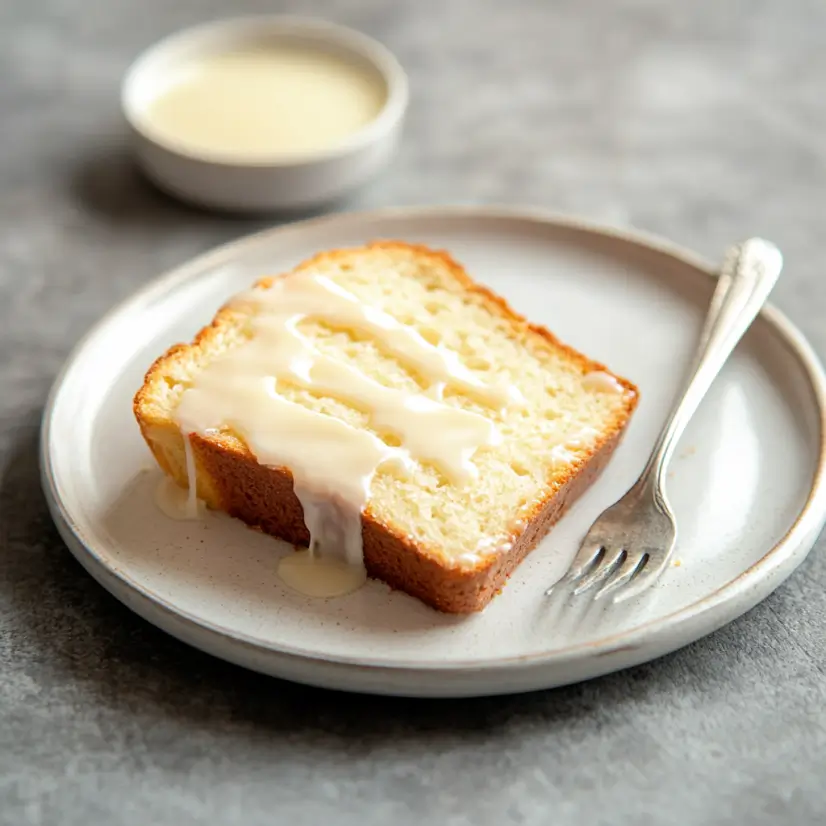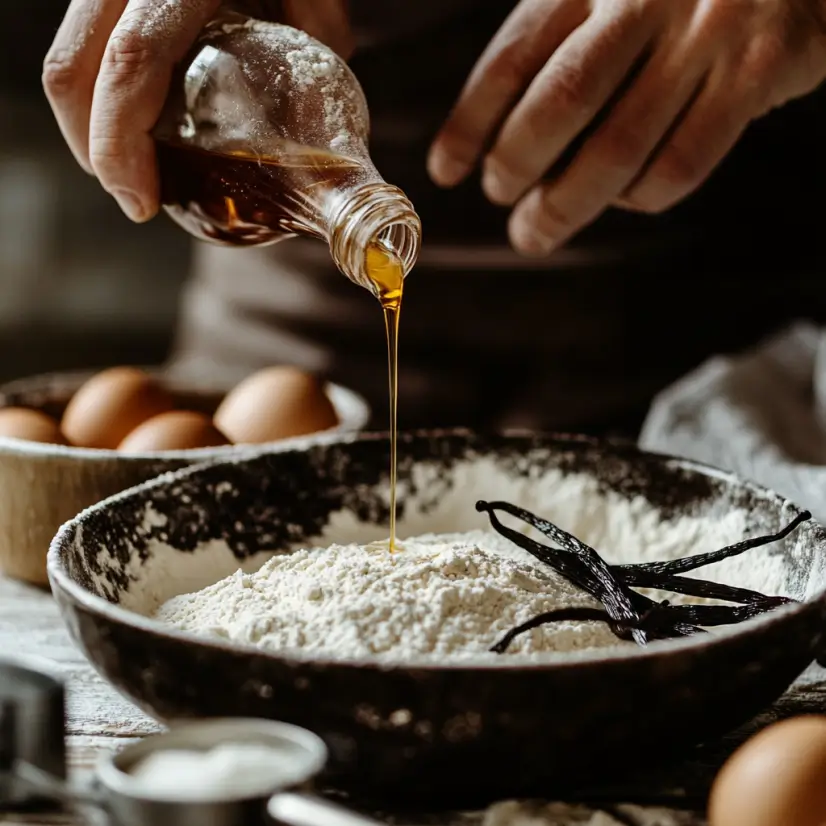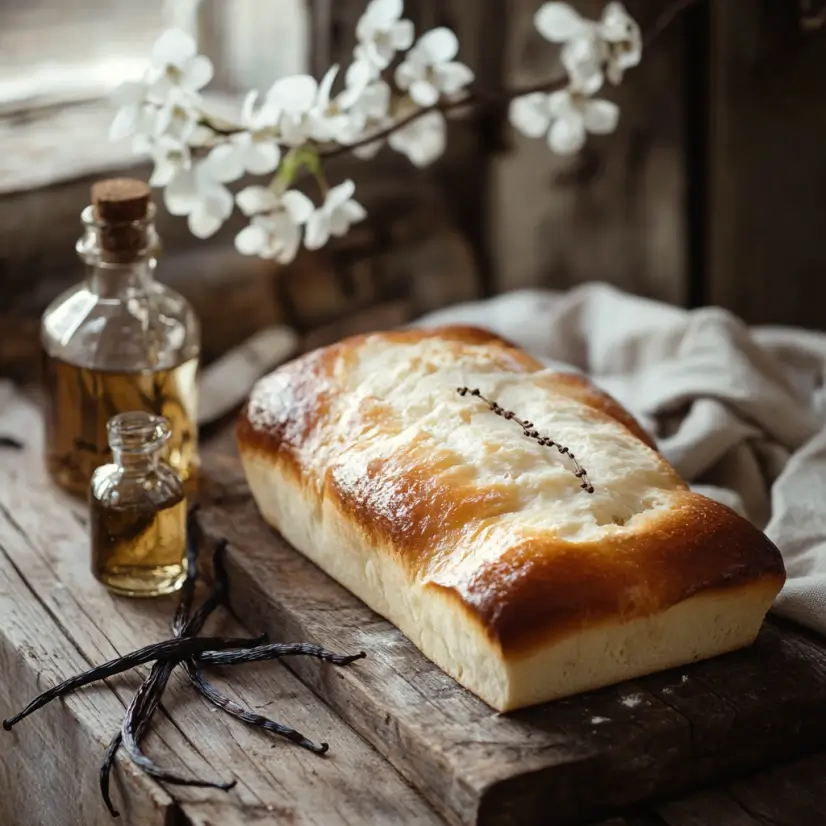Bread is a universal comfort food, and while many know the basics of making it, few understand the subtle roles played by specific ingredients. One such mystery lies in the vanilla used in bread recipes. Why is it added? Does it actually change the flavor? This article explores the magic of vanilla in bread, from its role as a flavor enhancer to its substitutes, scientific impact, and creative applications. Whether you’re a curious home baker or a professional chef, this guide will deepen your appreciation for the humble vanilla.
Table of Contents
The Role of Vanilla in Bread
Why Vanilla Is Used in Baking
Vanilla is often considered the “salt” of baking. It’s not just about adding flavor—it’s about amplifying the other ingredients. When you add vanilla to bread, it complements the natural sweetness of sugar and balances the earthy tones of flour. Historically, vanilla was prized for its versatility, becoming a staple in kitchens worldwide.
- Key flavor-enhancing properties: Vanilla’s subtle floral and creamy notes elevate any bread, from a simple loaf to more complex brioche. It doesn’t overpower; it enhances.
- Cultural significance: From French pâtisseries to American kitchens, vanilla has a legacy of making baked goods taste more complete.
Vanilla as a Flavor Enhancer in Bread
Much like salt brightens savory dishes, vanilla awakens the flavors in bread. In recipes like cinnamon rolls or banana bread, the addition of vanilla ensures that spices and fruits don’t taste one-dimensional. Without it, bread often lacks that “oomph.”
- Impact on sweet breads: Sweet bread recipes, like challah or fruit-studded loaves, gain depth from the warmth of vanilla.
- In savory breads: Though uncommon, vanilla can subtly enhance umami-rich loaves, such as those flavored with cheese or herbs.
Scientific Breakdown of Vanilla’s Effects
Why does vanilla work so well in bread? The answer lies in the chemistry. Vanilla contains vanillin, an organic compound responsible for its rich aroma and taste. This compound interacts with other ingredients to create a harmonious flavor profile.
- Vanillin and aroma: Vanilla molecules bind with fats in butter and oils, ensuring its scent lingers long after baking. This is why a loaf of bread with vanilla smells heavenly.
- Impact on taste perception: Vanilla tricks your brain into associating bread with a sense of warmth and comfort, enhancing the overall eating experience.
Bread is a universal comfort food, and while many know the basics of making it, few understand the subtle roles played by specific ingredients. One such mystery lies in the vanilla used in bread recipes. Why is it added? Does it actually change the flavor? This article explores the magic of vanilla in bread, from its role as a flavor enhancer to its substitutes, scientific impact, and creative applications. Whether you’re a curious home baker or a professional chef, this guide will deepen your appreciation for the humble vanilla.
Types of Vanilla and Their Influence on Brea
Pure Vanilla vs. Imitation Vanilla
When deciding on which vanilla to use in bread recipes, it’s important to understand the differences between pure vanilla and imitation vanilla. Pure vanilla extract, derived directly from vanilla beans, delivers a richer and more nuanced flavor. It’s particularly impactful in recipes where vanilla is a prominent flavor, like vanilla pound cake or custard-filled breads.
- Flavor differences: Pure vanilla boasts a deeper, more aromatic profile, while imitation vanilla tends to have a flat, synthetic taste. This makes pure vanilla preferable for bread recipes emphasizing subtle, layered flavors.
- Cost considerations: Imitation vanilla is far less expensive and works well in robust recipes like chocolate chip banana bread, where the vanilla isn’t the star of the show.
Forms of Vanilla: Extract, Beans, and Powder
Not all vanilla is created equal, and each form of vanilla—whether extract, beans, or powder—has its ideal uses in bread-making.
- Vanilla extract: This liquid form is the most common and versatile for bread recipes. Its alcohol-based formula ensures even distribution in the dough.
- Vanilla beans: These are perfect for premium bread recipes, where the specks of vanilla bean not only look visually appealing but also contribute to a robust flavor.
- Vanilla powder: This alcohol-free option is great for recipes requiring a dry ingredient, like quick bread mixes or specialty gluten-free loaves.
For more insights on the impact of ingredient choice, visit Why Add Vanilla Pudding Mix to Gluten-Free Bread.
Recipes and Uses of Vanilla in Bread
Classic Vanilla Sweet Bread Recipe
One classic way to highlight vanilla in bread is through a vanilla-infused sweet bread. This recipe showcases the ingredient’s ability to elevate even the simplest loaf.
- Ingredients: Combine flour, sugar, milk, eggs, butter, and vanilla extract for a tender, aromatic loaf.
- Process: Ensure the vanilla is added during the wet mixing stage for even flavor distribution.
- Tips: Use high-quality vanilla extract for the best results. For an extra touch, drizzle a vanilla glaze over the baked loaf.
For detailed recipes, consider exploring this Easy Homemade Vanilla Bread Recipe.
Innovative Vanilla-Inspired Bread Variations
Looking to experiment? Try adding vanilla to savory recipes for a surprising twist or combining it with spices like cinnamon or nutmeg in quick bread recipes. Vanilla pairs wonderfully with fruits like bananas and berries, enhancing the natural sweetness of the ingredients.
- Savory vanilla bread: Add a hint of vanilla to cornmeal bread or herb-flavored loaves for a subtle complexity.
- Spiced vanilla bread: Combine vanilla with cinnamon and cardamom for a chai-inspired loaf.
By incorporating vanilla creatively, you can transform ordinary bread recipes into unforgettable culinary expPart 2: Types of Vanilla and Their Influence on Bread (500 words)
Pure Vanilla vs. Imitation Vanilla
When deciding on which vanilla to use in bread recipes, it’s important to understand the differences between pure vanilla and imitation vanilla. Pure vanilla extract, derived directly from vanilla beans, delivers a richer and more nuanced flavor. It’s particularly impactful in recipes where vanilla is a prominent flavor, like vanilla pound cake or custard-filled breads.
- Flavor differences: Pure vanilla boasts a deeper, more aromatic profile, while imitation vanilla tends to have a flat, synthetic taste. This makes pure vanilla preferable for bread recipes emphasizing subtle, layered flavors.
- Cost considerations: Imitation vanilla is far less expensive and works well in robust recipes like chocolate chip banana bread, where the vanilla isn’t the star of the show.
Forms of Vanilla: Extract, Beans, and Powder
Not all vanilla is created equal, and each form of vanilla—whether extract, beans, or powder—has its ideal uses in bread-making.
- Vanilla extract: This liquid form is the most common and versatile for bread recipes. Its alcohol-based formula ensures even distribution in the dough.
- Vanilla beans: These are perfect for premium bread recipes, where the specks of vanilla bean not only look visually appealing but also contribute to a robust flavor.
- Vanilla powder: This alcohol-free option is great for recipes requiring a dry ingredient, like quick bread mixes or specialty gluten-free loaves.
For more insights on the impact of ingredient choice, visit Why Add Vanilla Pudding Mix to Gluten-Free Bread.
Substitutes and Alternatives to Vanilla
Natural Substitutes for Vanilla in Bread
If you’ve ever run out of vanilla extract while baking, don’t worry—there are several natural substitutes that can deliver similar flavor-enhancing results. These alternatives work well in bread recipes, maintaining balance and adding their own unique twist.
- Maple syrup: With its caramel-like sweetness, maple syrup can replace vanilla in equal parts. It’s especially great for recipes like banana bread or cinnamon rolls.
- Honey: A natural sweetener with floral notes, honey can mimic some of vanilla’s complex aromas. Use slightly less than the amount of vanilla required to avoid overpowering the flavor.
- Tonka beans: A less common but highly aromatic substitute, tonka beans provide nutty and vanilla-like notes. Grate them sparingly into bread dough for a luxurious touch.
For more ideas on flavor substitutions, explore Does Adding Vanilla to a Bread Recipe Alter the Rise?.
The Impact of Skipping Vanilla
Can you skip vanilla altogether in a bread recipe? Yes, but the result might not be as satisfying. Vanilla subtly enhances other ingredients, so bread without it may taste flat or one-dimensional.
- When to omit vanilla: In hearty bread recipes with robust flavors, like sourdough or rye, vanilla may not be necessary.
- When vanilla is crucial: Recipes with mild, sweet flavors—like pound cake-style loaves or vanilla-sugar bread—heavily rely on vanilla for depth and aroma.
If you’re looking for more ways to elevate your bread-making skills, check out other tips in the How to Make Your Bread Rise More guide.
FAQs About Vanilla in Bread
Does Vanilla Make a Difference in Bread?
Absolutely! Vanilla acts as a natural flavor enhancer, similar to salt, giving your bread a balanced and rounded taste. While it may seem subtle, its absence is noticeable in recipes where sweetness or aroma is key, such as sweet rolls or brioche.
For more bread-making tips, explore Easy Homemade Vanilla Bread Recipe.
Can I Use Imitation Vanilla in Bread?
Yes, but with some caveats. Imitation vanilla, made with synthetic vanillin, can work in strong-flavored recipes where the subtlety of pure vanilla isn’t needed. However, for recipes like vanilla bread or sponge cake, pure vanilla extract is worth the splurge for its authentic and rich taste.
How Can I Make My Own Vanilla Extract for Baking?
Making your own vanilla extract is surprisingly easy and cost-effective. Here’s a simple recipe:
- Split two vanilla beans lengthwise and place them in a clean jar.
- Fill the jar with one cup of unflavored vodka.
- Seal and store it in a dark place, shaking it weekly. After 6–8 weeks, your homemade extract will be ready to use!
For other creative recipes and tips, don’t miss our collection of bread-making secrets. Head over to Simply Yummy for more inspiration.
The Science and Benefits of Vanilla in Bread
Why Does Vanilla Improve Bread Flavor?
Vanilla’s role in bread goes beyond just taste—it’s a subtle game-changer. The key compound in vanilla, vanillin, interacts with other ingredients, amplifying their flavors. This makes bread taste more balanced and complex, even when the vanilla itself isn’t obvious. Without it, bread can seem flat or lack dimension.
For instance, in sweet bread recipes, vanilla complements sugars, enhancing their natural sweetness without overpowering other flavors. Even in savory variations, like herbed breads, vanilla can provide a gentle floral note that adds depth.
Vanilla’s Aromatic Chemistry in Baking
The science behind vanilla’s magic lies in its aroma. When heated during baking, the aromatic molecules in vanillin combine with the fats in butter or oils, creating a rich scent that enhances the bread’s appeal. This is why bread made with vanilla smells so inviting right out of the oven!
By understanding this, bakers can experiment with vanilla to bring out the best in their recipes. If you want to dive deeper into this topic, check out Does Adding Vanilla to a Bread Recipe Alter the Rise?.
Creative Uses for Vanilla in Bread Recipes

Vanilla as a Base for Flavor Combinations
Vanilla’s versatility makes it the perfect base for experimenting with other flavors in bread. Pair it with warm spices like cinnamon or nutmeg for a cozy loaf, or combine it with citrus zest for a bright, refreshing twist. Adding vanilla to fruit breads, like blueberry or banana loaves, enhances the natural sweetness of the fruit.
One creative idea is a vanilla-cardamom loaf—perfect for breakfast or as a tea-time snack. The subtle sweetness of vanilla balances the spice, creating a loaf that’s both unique and comforting.
Savory Applications of Vanilla in Bread
While vanilla is often associated with sweet recipes, it can add a surprising twist to savory breads. For example, a cornbread recipe with just a hint of vanilla balances the savory and sweet flavors beautifully. Similarly, adding vanilla to cheese bread can create a more nuanced taste.
If you’re looking for inspiration, explore Easy Homemade Vanilla Bread Recipe, which showcases vanilla’s versatility in bread-making.
By using vanilla creatively, bakers can elevate even simple bread recipes into something extraordinary. Whether you’re crafting a sweet loaf for dessert or a savory bread for dinner, vanilla offers endless possibilities to experiment and impress.
Common Misconceptions About Vanilla in Bread
Does Vanilla Only Add Sweetness?
One common misunderstanding about vanilla in bread is that it simply makes the bread sweeter. In reality, vanilla’s primary role is to enhance other flavors rather than contribute sweetness. Much like salt, vanilla boosts the natural taste of ingredients, creating a well-rounded flavor profile. Therefore, even recipes with minimal sugar benefit from vanilla’s balancing act.
When considering what does vanilla do in bread, think of it as a flavor amplifier. It doesn’t dominate but instead subtly elevates the taste of everything else in the recipe. However, it is important to measure vanilla carefully to maintain its subtle impact.
Can You Use Too Much Vanilla?
Another misconception is that more vanilla always means better flavor. While it’s tempting, too much vanilla can overwhelm the balance of flavors in bread. This is especially true for delicate recipes like sponge loaves or brioche, where subtlety is key. Thus, sticking to the recipe guidelines allows vanilla to shine without overpowering.
For more baking insights, explore our guide on Does Adding Vanilla to a Bread Recipe Alter the Rise?.
Tips for Storing and Using Vanilla in Baking
How to Store Vanilla for Maximum Freshness
To keep vanilla at its best, store it in a cool, dark place, away from direct sunlight and heat. Whether it’s pure extract, beans, or powder, proper storage prevents flavor loss and ensures long-term freshness. In particular, vanilla beans should be wrapped in wax paper and placed in an airtight container to maintain their quality.
Best Practices for Using Vanilla in Bread

To make the most of vanilla’s flavor in bread recipes, timing matters. For example, adding liquid vanilla extract during the mixing phase ensures even distribution. On the other hand, if using vanilla beans, scraping out the seeds and mixing them directly into the dough works best. In addition, using vanilla bean specks not only adds flavor but also creates a gourmet look and feel.
When pondering what does vanilla do in bread, it’s clear that storage and application techniques significantly influence the final product. Properly stored and skillfully used, vanilla can transform even the simplest bread into something extraordinary.
For additional tips and creative recipes, check out Easy Homemade Vanilla Bread Recipe. With the right techniques, vanilla can be the secret ingredient that takes your baking to the next level.

